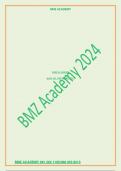Essay
HRB4801 ASSIGNMENT 2 2024 Your CEO attended a business expo and heard a few attendees talking about how their organisations have been transformed into learning organisations. He is considering transforming your organisation into a learning organisation;
- Course
- HRD4801 (HRD4801)
- Institution
- University Of South Africa (Unisa)
HRB4801 ASSIGNMENT 2 2024 Your CEO attended a business expo and heard a few attendees talking about how their organisations have been transformed into learning organisations. He is considering transforming your organisation into a learning organisation; however, he does not know what the process...
[Show more]




